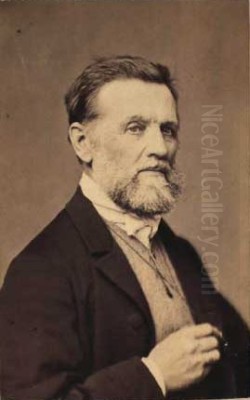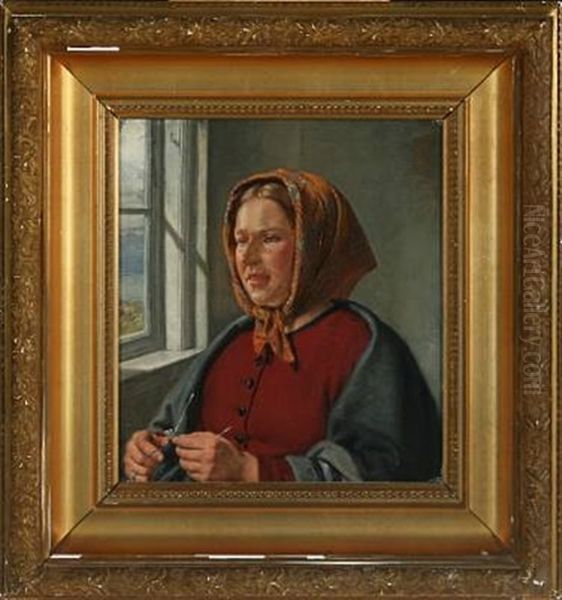
Jørgen Pedersen Roed (1808–1888) stands as a significant figure in the annals of Danish art, a prominent painter whose career unfolded during the vibrant period known as the Danish Golden Age. Born in Ringsted, Denmark, Roed's artistic journey was characterized by a meticulous approach to his craft, a deep appreciation for both the natural world and architectural grandeur, and a steadfast dedication to the principles of his mentors. His contributions spanned portraiture, landscape, architectural studies, and religious compositions, each bearing the hallmark of his refined technique and thoughtful observation. His Danish nationality is undisputed, and his life's work remains a testament to the artistic flourishing of 19th-century Denmark.
Early Life and Artistic Awakening
Jørgen Roed's inclination towards art manifested early in his life. At the tender age of 14, he embarked on his formal artistic training by enrolling at the prestigious Royal Danish Academy of Fine Arts in Copenhagen. This was a significant step, especially considering that his family had initially envisioned a more traditional career path for him. However, Roed's passion for painting was undeniable. His initial tutelage at the Academy was under the guidance of the portrait painter Heinrich Hansen, who likely provided him with a foundational understanding of capturing likeness and character.
The environment at the Copenhagen Academy was formative. It was an institution steeped in tradition yet on the cusp of a new era of artistic expression. Roed's early years there would have exposed him to the prevailing neoclassical ideals, but also to the burgeoning interest in naturalism and subjects drawn from Danish life and landscape. His dedication and talent were evident, as he diligently honed his skills in drawing and painting, laying the groundwork for a distinguished career.
The Pivotal Influence of C.W. Eckersberg
A crucial turning point in Roed's development was his tutelage under Christoffer Wilhelm Eckersberg (1783–1853). Eckersberg, often hailed as the "Father of Danish Painting," was a transformative figure who steered Danish art towards a greater emphasis on direct observation of nature, meticulous detail, and a clear, objective rendering of reality. He encouraged his students to paint outdoors and to study perspective and the effects of light with scientific precision.

Roed absorbed these lessons profoundly. Eckersberg's influence is palpable in Roed's careful compositions, his precise draughtsmanship, and his nuanced understanding of light and shadow. While Roed developed his own distinct style, the foundational principles instilled by Eckersberg remained a constant throughout his career. He became one of Eckersberg's most accomplished pupils, carrying forward the legacy of realism and technical proficiency that defined the Danish Golden Age. This period, roughly spanning the first half of the 19th century, saw artists like Roed turn their attention to Danish landscapes, everyday life, and national history, fostering a unique artistic identity for the nation.
The Italian Sojourn: Broadening Horizons
Like many artists of his era, Jørgen Roed undertook a transformative journey to Italy. From 1837 to 1841, he immersed himself in the rich artistic and cultural heritage of the Italian peninsula. This period was instrumental in shaping his artistic vision, particularly his interest in architectural painting and landscape. Italy, with its classical ruins, Renaissance masterpieces, and sun-drenched landscapes, offered a wealth of inspiration.
During his time in Italy, Roed produced numerous studies and paintings. He was captivated by the ancient Roman architecture, the picturesque towns, and the vibrant quality of Mediterranean light. This experience not only provided him with new subject matter but also refined his ability to depict complex architectural forms and capture atmospheric effects. His Italian landscapes and architectural views are characterized by their clarity, detailed observation, and a subtle romantic sensibility. He also created religious altarpieces during this period, further diversifying his oeuvre. The Italian journey was a rite of passage that enriched his palette, expanded his thematic concerns, and solidified his reputation as a versatile and skilled painter.
Artistic Style: Elegance, Precision, and Seriousness
Jørgen Roed's artistic style is often described as elegant, meticulous, and imbued with a certain gravitas. He approached his subjects with focused dedication and a high degree of technical skill. His brushwork is typically smooth and controlled, allowing for a high level of detail and a refined finish. In terms of color, his palette was often subtle and harmonious, though capable of rich expression when the subject demanded it.
A defining characteristic of Roed's work is its precision. Whether depicting the intricate details of a Gothic cathedral, the subtle play of light on a sitter's face, or the varied textures of a landscape, he demonstrated an unwavering commitment to accuracy. This precision was not merely technical; it was rooted in a deep respect for the subject matter. His architectural paintings, in particular, showcase his keen understanding of perspective and structure, rendering buildings with an almost tangible solidity. While his work aligns with the realism of the Danish Golden Age, there is often an underlying sense of order and a slightly reserved, serious mood that distinguishes his artistic voice.
Masterpieces and Notable Works
Jørgen Roed's oeuvre includes several works that are considered highlights of Danish Golden Age painting. Among his most celebrated architectural pieces is The Chancel of Roskilde Cathedral (also known as Background of Roskilde Cathedral), painted in 1836. This work masterfully captures the grandeur and intricate Gothic details of the historic Danish cathedral, a site of immense national importance as the burial church of Danish monarchs. The painting is lauded for its precise rendering of architectural elements, its handling of light filtering through the stained-glass windows, and its evocative atmosphere.
Another significant, albeit unfinished, work is Study from the Coast at Hellebæk. This piece reveals Roed's skill as a landscape painter and his ability to capture the specific character of the Danish coastline. Even in its incomplete state, the study demonstrates his keen observation of natural forms and atmospheric conditions.
His time in Italy yielded important works such as Study of a Scene from a Roman Villa Garden, which showcases his fascination with Italian landscapes and classical settings. Beyond these, Roed was a sought-after portraitist, capturing the likenesses of many prominent Danes of his time. His portraits are characterized by their psychological insight and dignified presentation. He also continued to produce religious works, including altarpieces for various churches, demonstrating his versatility across different genres. His works are held in high esteem and are prominently featured in institutions like the Statens Museum for Kunst (National Gallery of Denmark).
Personal Life, Academic Career, and Samsø
Jørgen Roed's personal life saw him marry Emilie Mathilde Kruse in 1842. Their engagement had begun in 1837, but the wedding was delayed, possibly due to circumstances related to Emilie's brother, August Kruse, who was an estate manager. The wedding ceremony took place at Trane Church, with celebrations held near Ørnsbrug. This connection to the Kruse family and the island of Samsø, where they had ties, became a recurring theme in his later life.
Professionally, Roed achieved significant recognition. He became a professor at the Royal Danish Academy of Fine Arts in Copenhagen in 1862, a position that allowed him to influence a new generation of Danish artists. Despite his academic responsibilities in the capital, Roed maintained a strong connection to Samsø. He visited the island regularly, finding inspiration in its landscapes and people. Among the works created there are depictions of the notable stone pillar known as "Knøsen" and portraits of members of the Kruse family, further intertwining his personal and artistic life. His dedication to both his teaching and his personal artistic practice continued throughout his later years.
Contemporaries and the Artistic Milieu
Jørgen Roed was an integral part of a vibrant artistic community during the Danish Golden Age. His primary mentor, C.W. Eckersberg, was surrounded by a talented group of students who collectively shaped the course of Danish art. Among Roed's notable contemporaries were:
Christen Købke (1810–1848): Celebrated for his sensitive landscapes, portraits, and architectural views, often depicting the outskirts of Copenhagen. Købke is considered one of the most gifted painters of the Golden Age.
Martinus Rørbye (1803–1848): Known for his genre scenes, landscapes, and Orientalist paintings, Rørbye, like Roed, traveled extensively, including to Italy, Greece, and Turkey.
Wilhelm Marstrand (1810–1873): A versatile artist famed for his lively genre scenes, historical paintings, and portraits. He also spent considerable time in Italy.
Constantin Hansen (1804–1880): A close associate, Hansen was known for his historical paintings, portraits, and depictions of Italian life. Roed and Hansen reportedly collaborated on at least one occasion, on a work depicting a Danish rural skiing scene.
P.C. Skovgaard (1817–1875): A leading landscape painter, particularly renowned for his depictions of Danish beech forests and national romantic landscapes.
Dankvart Dreyer (1816–1852): Another gifted landscape painter, known for his atmospheric and often melancholic depictions of the Danish countryside, particularly Jutland.
Johan Thomas Lundbye (1818–1848): A key figure in national romantic landscape painting, Lundbye focused on capturing the quintessential Danish scenery and its animal life.
Heinrich Hansen (1787-1828): Roed's first teacher, a portraitist who provided his initial academic grounding.
Holger Roed (1846-1874): Jørgen Roed's son, who also became a painter, though his career was tragically short. He followed in his father's footsteps, studying at the Academy.
Roed also interacted with earlier influential figures like Jens Juel (1745–1802), a leading portraitist of the preceding generation whose work laid some groundwork for the Golden Age, and Nicolai Abildgaard (1743–1809), Eckersberg's own teacher and a prominent neoclassical history painter.
Roed participated in the artistic life of Copenhagen, including activities organized by the Kunstforeningen (Art Society), which played a role in promoting and selling the works of contemporary artists. While the artistic environment was generally collegial, a degree of professional competition undoubtedly existed among Eckersberg's many talented disciples, each striving to establish their own artistic identity and secure patronage. Roed navigated this milieu successfully, earning respect for his skill and dedication.
Enduring Legacy
Jørgen Roed's legacy is firmly established within the context of the Danish Golden Age. He is remembered as an artist who masterfully balanced technical precision with aesthetic sensibility. His contributions to architectural painting are particularly noteworthy, offering invaluable visual records of historical structures rendered with both accuracy and artistry. His portraits provide a window into the society of 19th-century Denmark, while his landscapes capture the subtle beauty of both his homeland and the Italian scenes that inspired him.
As a professor at the Royal Danish Academy, he played a direct role in shaping the next generation of artists, ensuring the continuation of the strong technical grounding that characterized the Eckersberg school. While perhaps not possessing the same degree of innovative flair as some of his contemporaries like Købke, Roed's consistent quality, his dedication to his craft, and the elegance of his work secured him a lasting place in Danish art history. His paintings continue to be admired for their meticulous detail, their harmonious compositions, and their quiet dignity, reflecting the refined spirit of an era that remains a high point in Denmark's cultural heritage.
Conclusion
Jørgen Roed was more than just a painter; he was a custodian of an artistic tradition and a keen observer of the world around him. From his early studies in Copenhagen to his influential professorship, and through his formative travels in Italy, Roed consistently demonstrated a profound commitment to the art of painting. His works, whether grand architectural depictions, insightful portraits, or serene landscapes, speak of a disciplined mind and a skilled hand. He remains a respected and important figure, a true representative of the Danish Golden Age, whose art continues to offer insights into the aesthetic and cultural values of 19th-century Denmark.